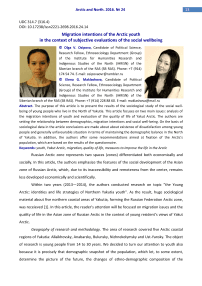Migration intentions of the Arctic youth in the context of subjective evaluations of the social wellbeing
Автор: Olga V. Osipova, Elena G. Maklashova
Журнал: Arctic and North @arctic-and-north
Рубрика: Economics, political science, society and culture
Статья в выпуске: 24, 2016 года.
Бесплатный доступ
The purpose of this article is to present the results of the sociological study of the social wellbeing of young people who live in the North of Yakutia. This article focuses on two main issues: analysis of the migration intentions of youth and evaluation of the quality of life of Yakut Arctic. The authors are setting the relationship between demographics, migration intentions and social well-being. On the basis of sociological data in the article conclusions are made about about existence of dissatisfaction among young people and generally unfavourable situation in terms of maintaining the demographic balance in the North of Yakutia. In addition, the authors offer some recommendations aimed at fixation of the Arctic’s population, which are based on the results of the questionnaire.
Youth, Yakut Arctic, migration, quality of life, measures to improve the life in the Arctic
Короткий адрес: https://sciup.org/148318635
IDR: 148318635 | УДК: 314.7(316.4) | DOI: 10.17238/issn2221-2698.2016.24.14
Текст научной статьи Migration intentions of the Arctic youth in the context of subjective evaluations of the social wellbeing
Russian Arctic zone represents two spaces (zones) differentiated both economically and socially. In this article, the authors emphasize the features of the social development of the Asian zone of Russian Arctic, which, due to its inaccessibility and remoteness from the center, remains less developed economically and scientifically.
Within two years (2013—2014), the authors conducted research on topic “the Young Arctic: identities and life strategies of Northern Yakutia youth". As the result, huge sociological material about five northern coastal areas of Yakutia, forming the Russian Federation Arctic zone, was receieved [1]. In this article, the reader's attention will be focused on migration issues and the quality of life in the Asian zone of Russian Arctic in the context of young resident’s views of Yakut Arctic.
Geography of research and methodology. The area of research covered five Arctic coastal regions of Yakutia: Allaikhovsky, Anabarsky, Bulunsky, Nizhnekolymsky and Ust-Yansky. The object of research is young people from 14 to 30 years. We decided to turn our attention to youth also because it is precisely that demographic snapshot of the population, which let, to some extent, determine the picture of the future, the changes of ethno-demographic composition of the population, which may become visible in future. This article presents the results of the questionnaire, forming which formed basic foundation of the sociological part of research. Selection is quota and age-gender group. 510 respondents were interviewed during questioning
(see Table 1).
Sociological research selection (in % for region)
Table 1
* here and further ISPN — Indigenous small-numbered peoples of the North
Migration intentions of youth. Appeal to migration intentions of youth of Yakutia north is not random, as it is well-known, and we fully share the view that the level of migration activity largely depends on the quality of life. Answeres to the question "Are you going to stay or to leave your region?" indicated high level of desire of young people to leave (see Figure 1).
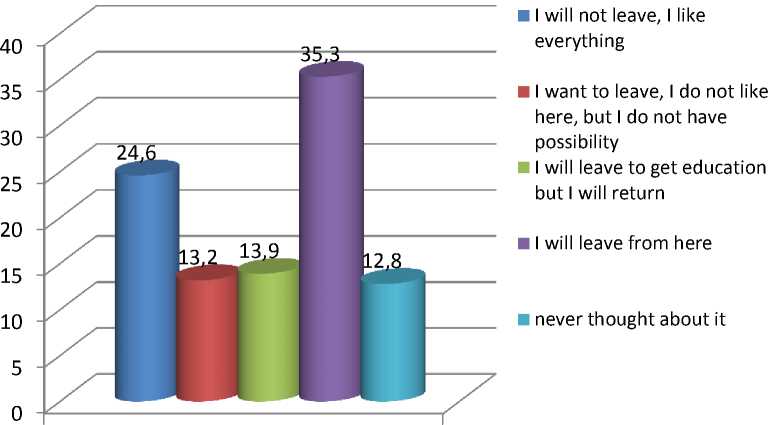
Figure 1. Migration intentions of youth (in %)
Only 37.4% of respondents did not intend to migrate. About half of the respondents (49.2%) intend to somehow participate in the migration processes. Rather high number of dissatisfied with their situation and unable to migrate (13.9%). Important component of the analysis in this case is the question which exactly groups of young people have migration intentions.
Sociology rather long ago set the fact that answers greatly vary depending on gender and age of responders. Therefore, first of all, we consider the gender and age characteristics of the respondents.
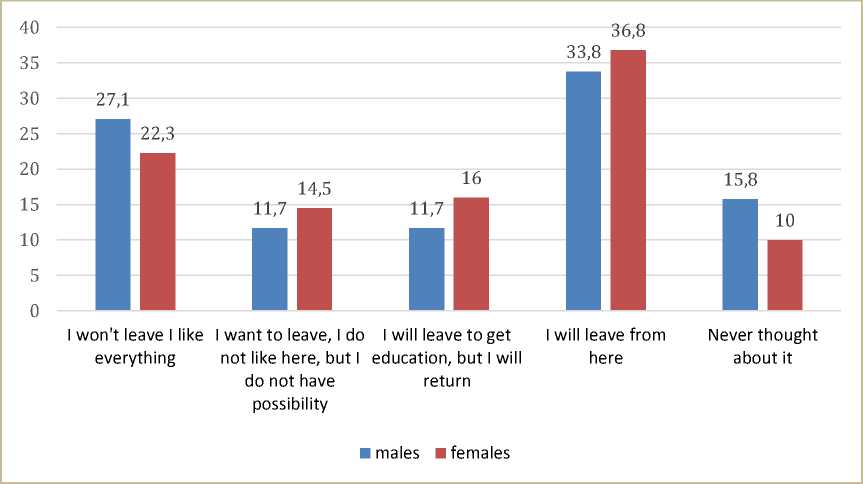
Figure 2. Gender cross-section of migration intentions of youth (in %)
As can be seen from Figure 2, females are more active in terms of migration. In scientific research it repeatedly emphasized that female migration is rather complicated, little-studied phenomenon that includes both labor and marriage migration. As for the results, a few facts should be mentioned in this respect: males are more flexible in choosing a place of future residence and plan to leave for both within the territory of Yakutia, and Russia in general. But females as a rule tend to be limited by the territory of Yakutia; males more often than females are set to stay at their native land and more seldom think about changing the place of residence. It seems to us, that revealed activity to migration among young women of ferile age is a dangerous trend that could lead to a change in the gender balance in the direction of reducing the category of fertile age women in the demographic structure of these areas and to narrowing of the possibilities of marriage choice.
Speaking about age peculiarities, it is necessary to mention that the highest desire of young people to leave is typical for the youngest age category of 14 to 17 years (see Figure 3). However, among the older age groups, the number of intending to go still remains around 30%. It is necessary to note that the peaks of trips according to statistics are typical for school-leaving age, as well as for age of 30-39 years. Furthermore, as shown in Figure 3, with the growth of respondents’ age, the desire to stay in the area occurs, with position "I like everything".
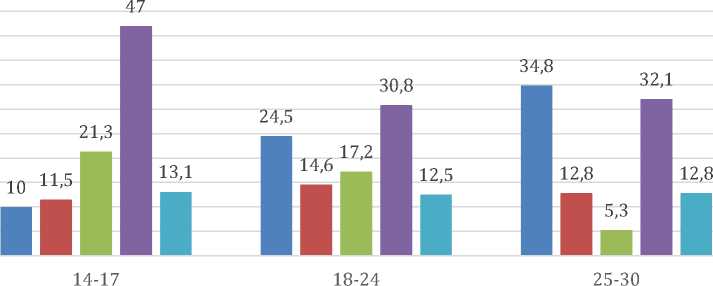
I won't leave I like everything
I want to leave I don't like here, but I do not have possibility
I will leave to get education but I will return
I will leave
Never thought about it
Figure 3. Age cross-section of migration intentions of youth (in %)
Yakut Arctic is not a mono-ethnic region. Since Soviet times, times of development of the Arctic, a kind of multi-ethnic environment appeared here, symbiosis of cultures happened. With the loss of the state interest in the Arctic territories resulted from political and economic reforms, social sector of the Arctic began to come to "desolation" caused among others by mass exodus of the population. Expeditions into five analized regions have shown that inert development of social system attempting to operate on the principles of interaction laid down earlier, still changing rapidly. Thus today we talk about changing of ethnic structure in areas, observe new forms of ethnic groups adaptation to changing socio-economic conditions.
Undoubtedly the representatives of different nationalities have different migration intentions (see Figure 4). It is noticeable that the Russian youth is more disposed to leave, as well as the population defined as "mixed nationality". This shows that the change of the ethnic picture in the Yakut Arctic is still not finished. Currently, changing the ethnic composition of the population is typical for the district centers. If before there was dominance of the Russian population observed, now with the massive departure of last, there is a fairly active migration of indigenous small-
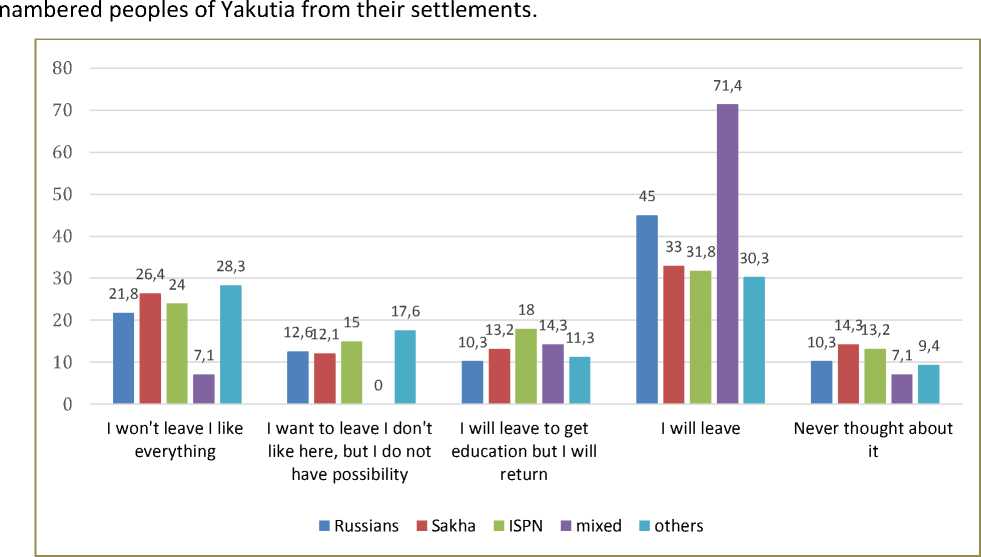
Fugure 4. Ethnic cross-section of migration intentions of youth (in %)
Summing up the analysis of migration intentions of youth, it should be noted that young people quite actively intends to participate in the migration process. And in the future we may deal with significant ethno-demographic changes in the Arctic regions of Yakutia.1 First of all it will relate to the age and gender composition.
So why do we have a high percentage of those wishing to leave?
The quality of life in northern Yakutia and social well-being . The quality of life is directly connected to the preservation of working population, in particular young people of the Arctic zone of Russia. Partial satisfaction of human needs has a significant impact on the decision to migrate. Respondents were offered to put value of the quality of life through the following social services: recreation and culture; health care; education. The estimation was made using ten-point scale, where 1 meant the lowest estimate, and 10 — the highest. In general, as shown reflected Figure 5, the average assessment of the quality of social services is not high, even low. The youth of Arctic regions of Yakutia gave the highest rate to the level of provided education among the other spheres of social life, then recreational services. Low rating was given to the medical care. Sociological data completely coincide with the statistical characteristics of the level of development of social spheres in the Yakut Arctic [2; 3; 4]. Hierarchy of the social areas obtained on the basis of average estimates on quality of service is almost identical with the rates of social services received as a result of sociological research in three regions of Arctic Yakutia (Ust-Yansky, Anabarsky and Allaikhovsky) among the population aged 18 and older, also conducted by the authors. Results for all ages research show that the population gave the highest rate to the quality of education (average rate 5.0), then — recreational services and culture (average rate 4.38). People are dissatisfied by health care most of all (average score 3.68). Thus, it can be noted that young people, inspite of typical for their age immaturity of consciousness, are able to evaluate adequately and according to the opinion of the older generation their surrounding social reality.
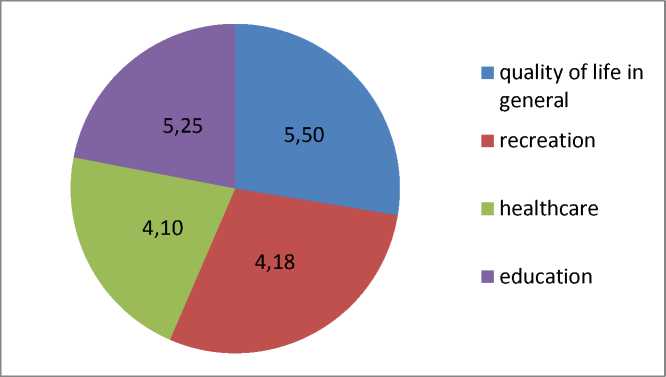
Figure 5. Average rates of quality of life in the Yakut Arctic.
For a demonstration of more illustratory results and comparative analysis we decided to distinguish two groups of young people: the first group — those wishing to leave the Arctic territories, which amounted to 35.3% of the respondents; the second — those who indicated that they had no intentions of migration (24.6% of respondents) (see Table 2).
Table 2
Demographic indicators of two groups of respondents (in %)
Thus, as it can be seen from Table 2 and to confirm above mentioned results, gender, age,
Fugure 6. Comparative diagram of rates of life quality in total in North of Yakutia (in % for each meaning) Those willing to stay are indicated as red, those willing to leave are indicated as dark brown
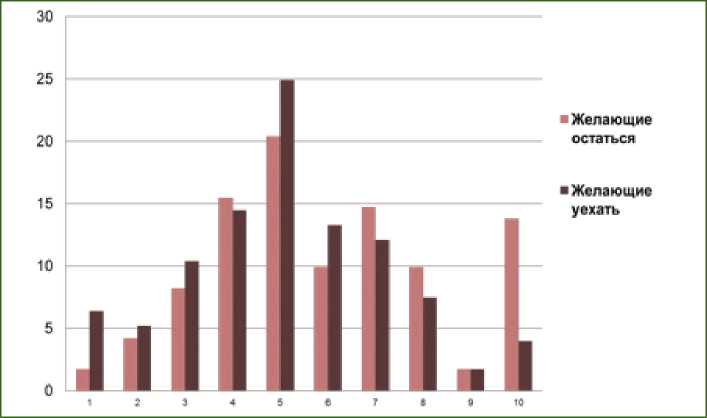
Young people were also offered to put value to the quality of life in total in the north of Yakutia. Youth, which does not yet have migration intentions, is more optimistic in their rates of the quality of life in the north of Yakutia. Potential migrants express more dissatisfaction with the quality of life in general, in addition, they tend to give the average estimate that perhaps is indication of a certain inertia, detachment from the social environment due to the present status of "temporary worker" rather than those who does not yet have migration intentions (see Figure 6).
Referring to the characterization of the analyzed social spheres. Young people who have migration intentions tend to averaging as well when evaluating the quality of education received or obtaining in Arctic (see Figure 7). Moreover, if we compare the positive scale (rates of 6 and above), the total sum of answers of the youth, who plans to leave, shows that they often put a positive value for quality of education than the youth who is going to stay. The responses of young people wishing to stay, on the contrary, have "notes" of discontent by state of this social sphere.
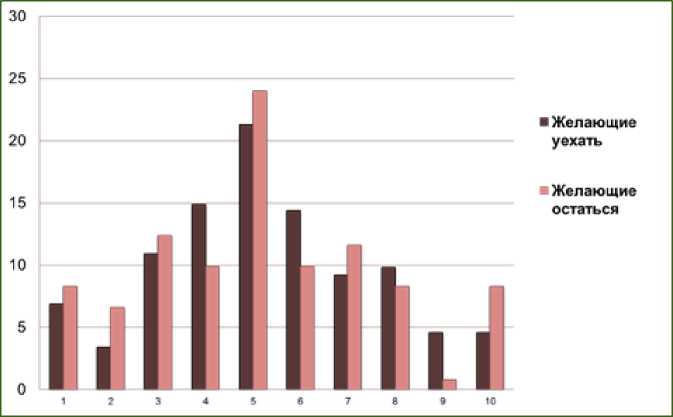
Figure 7. Comparative diagram of rates of the quality of education (in % for each meaning).
Those willing to stay are indicated as red, those willing to leave are indicated as dark brown
Health care services and their quality in the Arctic are really low, that is, first of all, due to the low-skilled personnel, shortage of doctors2. The majority of respondents tend to put the lowest scores, and greater concern for the state of medicine is seen in young people who wish to remain in their native lands, which is quite logically sound (see Figure 8).
2 Kompleksnaia programma Respubliki Sakha (Iakutiia) “Poetapnoe ustranenie defitsita meditsinskikh kadrov na 2013—2017 gody”. Utverzhdena postanovleniem Pravitel'stva Respubliki Sakha (Iakutiia) ot 01 aprelia 2013 g. № 108. URL: (accessed: 31 May 2016).
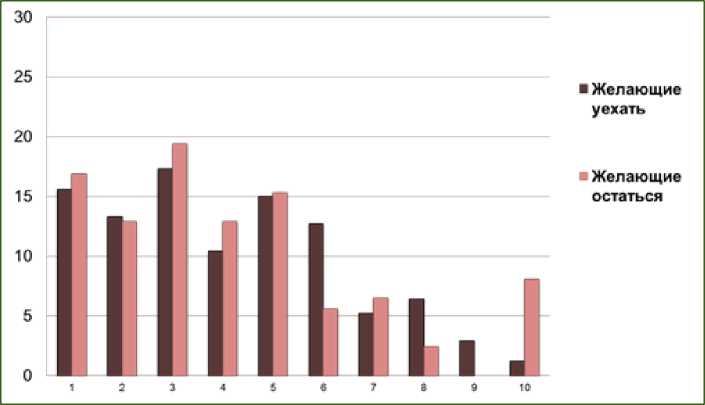
Figure 8. Comparative diagram of rates of the quality of healthcare cervices (in % for each meaning) Those willing to stay are indicated as red, those willing to leave are indicated as dark brown
Referring to the rates of recreation — the most important social service for younger generation. High level of dissatisfaction with recreational area is typical for precisely those young people wishing to migrate. But negative evaluations were given as well by those who intend to stay, but frequency of positive rates was provided by those young people wishing to stay than those wishing to move (see Figure 9).
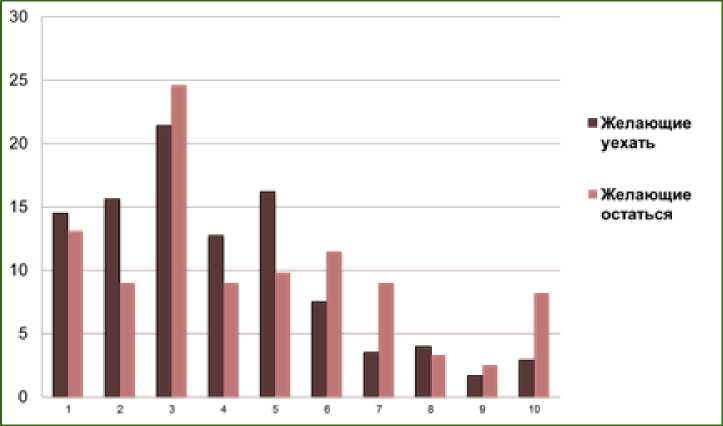
Figure 9. Comparative diagram of rates of the quality of recreation (in % for each meaning) Those willing to stay are indicated as red, those willing to leave are indicated as dark brown
As you can see, there are different views on the living conditions in Arctic among young people, wishing to leave and stay in their native area. And the recreational sphere is the most burning issue of social development of the Yakut Arctic as youth here think, especially those who have migration intentions.
We also could not leave without our attention the questions relating to the definition of the desired vector of reforms in the Yakut Arctic. Respondents were offered to answer a closed question: "What, in your opinion, is necessary to improve for quality of life in the North of Yakutia?", with a list of 16 possible answers structured in the following units: social and domestic; pricing and procurement; social policy; ethno-cultural development and support of traditional lifestyles; national and migration policy; development of the economic sector; staff assistance; international relationships.
We identified a hierarchy of priority measures to improve quality of life in Arctic, shown in Figure 10 in the light of the views of the two selected groups. As a result, it may be noted that anyhow to secure the population, in particular young people, in Yakut Arctic, it is necessary to satisfy at least primary needs of the population: the living conditions and quality of social services. At the same time young people wishing to stay emphasize that the return to the practice of state protectionism of the northern territories is the promising way of fixing population there.
Opinion of youth wishing to stay
Opinion of youth wishing to leave
1 Increase of dotations and benefits
1 Improvement of living conditions
2 Improvement of living conditions
2 Improvement of healthcare
3 Price regulation
3 Price regulation
4 Improvement of healthcare
4 Increase of dotations and benefits
Figure 10. Hierarchy of measures to improve quality of life in Arctic.
Conclusion
System monitoring of the quality of life in Arctic, arranged not only on the basis of statistical indicators, but also on sociological studies, will provide more objective data on changes of the social well-being of inhabitants of the Arctic territories and their intentions, as well as the problems of management of social and economic development of the Arctic zone of Russian Federation.
The results of our sociological research show that young people living in the Yakut Arctic, is not satisfied with the social conditions of life. This gives a poor prognosis for the future in terms of maintaining the demographic balance in this territory because dissatisfaction is directly connected with the migration intentions of young people. We tend to agree with fellow scientists, also from Murmansk that "crises come and go away. But the most effective investments — investments in human capital. It is people who are in the process of real activity: any "import substitution" or successful work and military service in the Arctic are not possible without their knowledge and skills" [5, p. 139]. Masloboev V., in turn, emphasizes the importance of the system of professional education: "We need specialists familiar with the specifics of use of theoretical knowledge and practical skills in conditions of the Far North, socially adapted to life in Arctic. The set of measures is needed aimed at promoting of the engineering education on the one hand, and keeping young people in the region as the formation, on the other hand, as well as modernization of existing regional system of professional education"[6, p. 96].
According to opinion of youth, the hardest situation is in the sphere of culture and recreation. It is no coincidence that young people who have intentions to migrate, estimated quality of leasure as very low, as opposed to the quality of education. Education is evaluated with more satisfactory quality in the opinion of young people. In fact, school is not only a source of knowledge, but also the only "place of entertainment" for the youth in Arctic, where there are no any leisure facilities. More positive situation in the sphere of education is connected also with that fact that for people wishing to leave, the continuation of education is the key, which gives them possibility to migrate. Those who stay for various reasons reconcile with situation and try to ignore the negative aspects in their daily life, putting relatively high values to the quality of life there.
It can be concluded that the activities in the maintenance of demographic balance of the Arctic territories should be carried out in two aspects: reducing migration and prevention of natural population decline. That is in order to reduce the outflow from the North it is necessary to modernize infrastructure in order to improve social and living conditions, and the policy of subsidizing of living in the Arctic regions of Russia is still needed to attract population.
As a practical outcome of the study it can be recommended for the state authorities to arrange the work on improving the cultural and leisure services, in particular to consider the matter of support of public organizations working directly in the Arctic regions and carrying out cultural and leisure activities, to develop ranked system to attract qualified professionals.
Список литературы Migration intentions of the Arctic youth in the context of subjective evaluations of the social wellbeing
- Osipova O., Maklashova E. Youth of the Arctic: Migration Intentions and Social Expectation. Journal of Siberian and Far Eastern Studies. 2014. № 10, pp. 6—44.
- Kompleksnyj analiz dejatel'nosti uchrezhdenij kul'tury Respubliki Saha (Jakutija). Ignat'eva V.B., Tomaska A.G., Maklashova E.G., Sannikova Ja.M., Osipova O.V., Fedotova N.D. Otchjot o NIR № 22/14 ot 12.11.2014. Avtonomnoe uchrezhdenie Respubliki Saha (Jakutija) «Agentstvo realizacii kreativn-yh tehnologij i innovacij kul'tury Arktiki». 364 p.
- Zdravoohranenie v Respublike Saha (Jakutija): Statisticheskij sbornik. Saha (Jakutija) stat. Jakutsk, 2015.
- Jetnosocial'naja adaptacija korennyh malochislennyh narodov Severa Respubliki Saha (Jakutija). S.M. Baisheva i dr. Novosibirsk, 2012. 363 p.
- Tripol'skij R.I. Arktika: izmenenie prioriteov razvitija. Severnyj morskoj put': razvitie arkticheskih kommunikacij v global'noj jekonomike «Arktika-2015»: VI Vserossijskaja morskaja nauchnoprakticheskaja konferencija: materialy konferencii, Murmansk, 13—14 maja 2015 g. / Feder. agentstvo po rybolovstvu, FGBOU VPO «Murman. gos. tehn. un-t»; red. kol.: Koz'menko S. Ju., Selin V.
- S., Savel'ev A. N., Shhegol'kova A.A. Murmansk: Izd- vo MGTU, 2015. pp. 136—139. URL: http://narfu.ru/ aan/Encyclopedia_Arctic/Murmansk_May_2015.pdf (Accessed: 31 May 2016).
- Masloboev V.A. Opyt integracii Kol'skogo nauchnogo centra RAN s vuzami po resheniju kom-pleksnyh zadach ustojchivogo razvitija AZRF. Arktika i Sever. 2015. № 19, pp. 96—114. URL: http://narfu.ru/upload/iblock/ea6/08-_-masloboev.pdf (Accessed: 31 May 2016).

